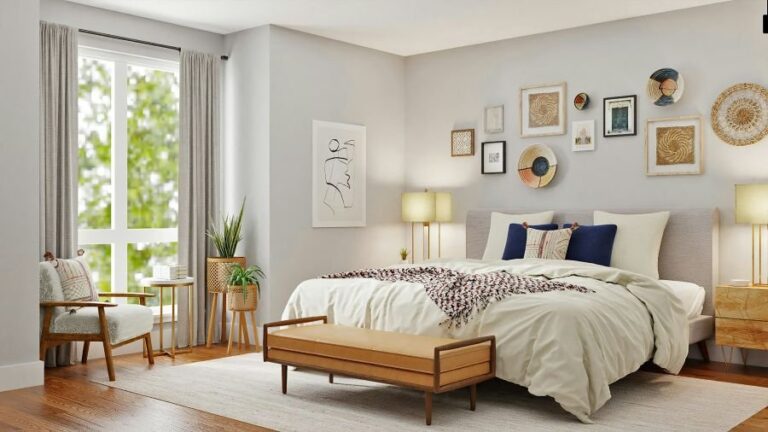Start with the Basics: Decluttering and Organization
The first step in any bedroom makeover is clearing out the unnecessary. Remove items that don’t belong, organize your closet, and consider investing in smart storage solutions like under-bed containers or a stylish dresser. A clutter-free space promotes better sleep and reduced anxiety, setting the foundation for your bedroom’s transformation. Consider implementing a regular organization system to maintain the serenity of your space.
Set the Right Mood with Color
Color psychology plays a crucial role in bedroom design. Soft blues promote tranquility, while gentle greens connect you with nature. Warm neutrals like beige and gray create a timeless, sophisticated atmosphere. Consider painting an accent wall or introducing your chosen colors through bedding and accessories. The key is to select shades that make you feel calm and relaxed, as these colors will influence your mood both consciously and subconsciously.
The Centerpiece: Your Bed
Invest in quality bedding – it’s worth every penny. Layer your bed with breathable cotton sheets, a comfortable duvet, and an assortment of pillows in varying sizes. Consider upgrading your mattress if it’s over eight years old. A supportive mattress foundation and an upholstered headboard can add both comfort and visual interest. Take time to research different mattress types and bedding materials to find what works best for your sleeping style and comfort preferences.
Ceiling Fan: The Overlooked Essential
A well-chosen bedroom ceiling fan can transform both the functionality and aesthetics of your bedroom. Beyond providing crucial air circulation, modern ceiling fans come in various stylish designs that can serve as striking visual elements. Look for models with multiple speed settings and reversible motors – this allows you to circulate warm air downward in winter and create cooling breezes in summer. When selecting a fan, consider the room’s size to ensure proper air movement, and choose a design that complements your overall décor scheme. LED-integrated fans can provide additional lighting options while saving energy.
Lighting Layers
Create layers of lighting for different moods and times of day. Install dimmer switches for overhead lights, add bedside lamps for reading, and consider soft LED strips behind your headboard for ambient lighting. Natural light is equally important – invest in window treatments that can both block light for sleeping and let it in during waking hours. Consider adding a mix of task lighting for specific activities and ambient lighting to create atmosphere. Smart bulbs can allow you to program different lighting scenes for various times of day.
Personal Touches and Décor
Make the space uniquely yours with carefully chosen décor. Hang meaningful artwork, display cherished photographs, or add a cozy reading nook with a comfortable chair and small side table. A plush area rug can add warmth and texture while absorbing sound. Consider the scale of your decorative pieces – oversized art can create drama, while smaller grouped items can tell a more intimate story. Remember that less is often more when it comes to bedroom décor.
Engaging the Senses
Creating a truly relaxing bedroom environment involves engaging all the senses. Add some greenery with low-maintenance plants that can thrive in your specific light conditions. Incorporate subtle scents through a diffuser or high-quality candles, being careful not to overwhelm the space. Consider a white noise machine or small bluetooth speaker for ambient sound. The texture of your textiles – from your carpet to your curtains – adds another sensory dimension to the room.
Practical Considerations
When revamping your bedroom, don’t forget practical elements that can enhance your daily routine. Consider adding a small bench at the foot of your bed for seating while dressing, or install floating shelves for additional storage without taking up floor space. Think about the placement of electrical outlets and consider adding USB charging stations or a wireless charging pad on your nightstand. Ensure pathways through the room are clear and well-lit for safety during nighttime trips to the bathroom.
Temperature and Comfort Control
Beyond your ceiling fan, consider other ways to maintain optimal sleeping temperatures. Thermal curtains can help regulate room temperature, while mattress toppers with cooling or warming properties can provide additional comfort. Position your bed away from drafts and consider adding a small humidifier or dehumidifier depending on your climate.
Maintaining Your Sanctuary
Once you’ve created your perfect bedroom, maintain its peaceful atmosphere through daily habits. Make your bed each morning, keep surfaces clear, and regularly refresh your linens. Dust your ceiling fan blades regularly to prevent dust distribution and maintain air quality. Implement a seasonal cleaning schedule for deeper tasks like rotating your mattress or cleaning window treatments.
Remember that creating your ideal bedroom is an ongoing process. Take time to live in the space and adjust elements as needed. Your bedroom should evolve with your needs while maintaining its core function as a peaceful retreat. Pay attention to what helps you relax and what might be disrupting your rest, and make adjustments accordingly. The most successful bedroom design is one that not only looks beautiful but also functions perfectly for your lifestyle and sleep habits.



